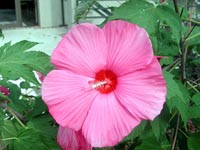Resource Library
Plant of the Week: Rose Mallow (Marsh Mallow)
The University of Arkansas System Division of Agriculture does not promote, support or recommend plants featured in "Plant of the Week." Please consult your local Extension office for plants suitable for your region.
Plant of the Week
Marsh Mallow, Rose Mallow
Latin: Hibiscus moscheutos

My marsh mallow has been in bloom for several weeks and is causing its usual gaudy display. It is covered with bright red blooms as large as a pie pan and is a real show stopper. Even though the blooms last only a singe day, they will be produced until fall arrives on a plant that is 5 feet tall and wide.
The flowers are typical of the hibiscus family to which the plant belongs, having 5 petals and a long finger-like stamenoid column extending from the center of the flower. The seed pod is a capsule-like structure similar to a short okra pod, another member of the hibiscus family. The overall effect of marsh mallow in the landscape is one of gaudiness and boldness -- attributes that are sure to attract lots of attention in the late summer landscape.
The (Hibiscus moscheutos) of the garden is a complex hybrid of three perennial species native to wet locations in the eastern United States, including Arkansas roadside ditches and swamps. The cultivar ‘Lord Baltimore’ was selected by an employee at Behnkie Nursery in Beltsville, Md., and is one of many large flowered selections available in the trade. The garden hibiscus can also be grown from seeds and will produce blooms the first year. First-year plants will usually be about 3 feet tall and not attain their working landscape height until the second year.
All of us know marsh mallows as those white puffy things you roast over a campfire, not a garden perennial. What gives with the common name? As it turns out, the American mallows closely resemble a European species, Althaea officinalis -- also called marsh mallow, which has been used since Roman times as a medicinal plant and as a confection. The roots contain 25 percent mucilage, 11 percent sugar, 38 percent starch and 11 percent pectin, making them useful for creating the sticky confection we all know and love.
Modern marsh mallows are not made from the plant but are a mixture of flour, gum, egg-albumin and sugar. The common name "marsh mallow" really shouldn’t be applied to our American plants, but it is such an interesting story I hesitate to call it by the other common names.
Growing the marsh mallow is simple. Give them a decent soil, full sunlight and water during dry spells and they will prosper. They are ideal for wet spots in the garden but do not require such to flourish. Because they develop a massive root system, they should be used only in areas where there is at least 6 inches of top soil. Once established, they are long lived.
By: Gerald Klingaman, retired
Extension Horticulturist - Ornamentals
Extension News - July 15, 2003
The University of Arkansas System Division of Agriculture does not maintain lists of retail outlets where these plants can be purchased. Please check your local nursery or other retail outlets to ask about the availability of these plants for your growing area.